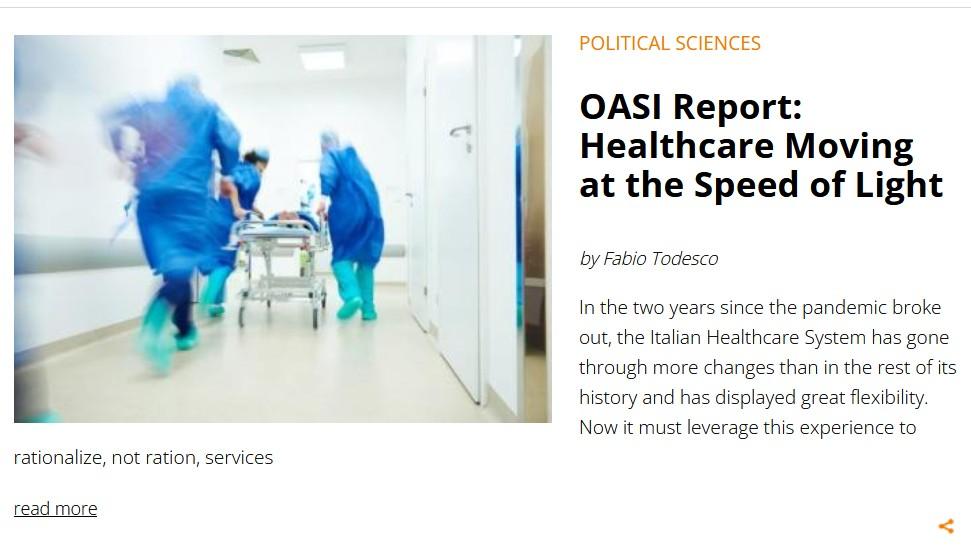
How Data Driven Planning Could Improve the Italian National Health System
THE ITALIAN SYSTEM HAS BEEN PROVIDING GOOD HEALTH OUTCOMES AT A REASONABLE COST FOR MORE THAN 40 YEARS. BUT SOMETHING MUST CHANGE TO OVERCOME THE POSTPANDEMIC CRISIS, ACCORDING TO ROSANNA TARRICONE AND WALTER RICCIARDIA good use of available - if sensitive - data is the key to improving the Italian National Health Service (SSN, Servizio Sanitario Nazionale), according to a comment by Rosanna Tarricone (Bocconi) and Walter Ricciardi (Università Cattolica del Sacro Cuore and advisor to the Italian Health Minister), newly published in The Lancet.
Data already collected by government agencies, regions, research institutes, clinical networks, and local health agencies “could be used to analyze and stratify population needs and identify areas and groups in need of intervention,” write Tarricone and Ricciardi in the most heartfelt of their six recommendations for systemic change, “starting from primary prevention programs, an underfunded area of SSN expenditure that needs expansion.”
“We sit on a treasure trove that, if processed with big data techniques and AI algorithms, could save millions of lives and billions of euros, as well as level the regional unbalances that afflict the Italian system,” Professor Tarricone says. “Authorities should feel compelled to find solutions to overcome the privacy concerns that currently prevent them from using such data.”
Since its inception in 1978, the SSN has been providing good health outcomes at a reasonable price for the Italian taxpayer. With life expectancy at birth equal to 83.6 years in 2019, Italy fares better than France (82.9), Germany (81.4), the UK (81.4) and the US (78.9) at a lower cost: 8.7% of the GDP vs 11.2% in France, 11.7% in Germany, 10.3% in the UK, and 16.9% in the US.
With the COVID pandemic, though, the system seems to be heading “towards the perfect storm,” write Tarricone and Ricciardi. “Rapid technological innovation (eg, newer, high-priced pharmaceuticals), an ageing population with multiple chronic conditions, and pressure to balance budgets are putting a strain on the supply, quality, and regional distribution of health services, provoking further discord among regions and with the central government.”
Tarricone and Ricciardi retrace the history of the SSN and note that the post-pandemic crisis risks being only the latest instance of a recurring situation, in which innovation and initiative lead to spiraling costs and difficulties, usually followed by austere cost-containment measures. This time, though, Next Generation EU, the recovery plan of the EU, is the occasion to permanently address the vulnerability of the SSN and strengthen its founding principles: universalism, equity, and solidarity – provided some measures regarding data-driven planning, prevention, and research; integrated care and technology; and investments in personnel are taken.
In particular, data-driven planning could allow to address differences in lifestyle and screening that currently lead to a 2-year difference in life expectancy between Calabria (the worst-off) and the Autonomous Province of Bolzano, which translate into a 17-year difference in life expectancy in perceived good health. On the same note, national colorectal and breast cancer screening programs report a 45% and 59% coverage in the South, compared with more than 95% in the North and Center.
“The question of the correct compromise between centralization and decentralization,” the authors conclude, “has not yet been unequivocally answered. If during times of emergency, planning, coordination, and control by the central government can guarantee uniformity of provider behavior and access to care, in non-pandemic times, we believe that a balance can be found as long as autonomy is paired with accountability in achieving certain objectives. Plus, the central government must develop the skills to design health policies of a national nature, thus providing local governments with the strategic means to formulate local plans and programs.”
Walter Ricciardi, Rosanna Tarricone, “The Evolution of the Italian National Health Service,”
The Lancet, available online 22 October 2021, DOI: https://doi.org/10.1016/S0140-6736(21)01733-5.
Related content

by Fabio Todesco
